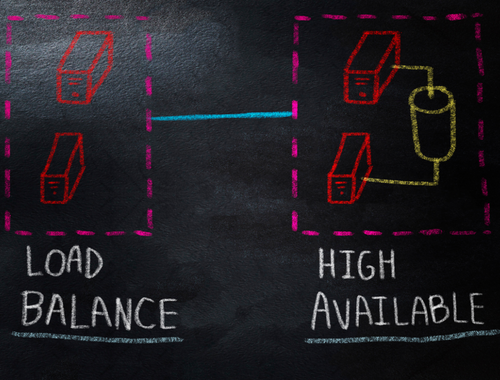Difference Between Availability and Reliability
When you pay for a service or buy an application or invest in just any underlying technology infrastructure, you want the service to operate seamlessly and flawlessly in real time without any hiccups. However, the degree to which a system is able to provide the expected service needs to be quantitatively assessed by defining proper measurable quantities. The quantitative assessment of system becomes crucial in system design, planning, implementation, and operation. There are two meaningful metrics used to quantitatively evaluate the capability of a system to provide the desired operation – reliability and availability – both of which are often mistakenly used interchangeably, but serve different purposes.

What is Availability?
Availability, also known as operational availability, is the ability of a system to deliver required services that are requested to do so. Availability ensures that an application or service is continuously available to its users. The formal definition would be – availability is the probability that a system, at a point in time, would remain operational under normal circumstances in order to serve its intended purpose. Simply put, it ensures that a system is able to perform required function under given conditions at a given point of time. Service availability can be quantified via a simple equation as service uptime divided by the sum of service uptime and service downtime.
Availability = Uptime/ Uptime + Downtime

What is Reliability?
Reliability is the ability of a system to deliver services correctly under given conditions for a given time period. Failures are inevitable in complex system; in fact, both native and virtualized systems are subject to the same fundamental error and failure scenarios. This takes into account the fact that if you’re using the system for something it’s not designed to do, you don’t get the same level of reliability. It is the degree of consistency of a measure. A system is said to be reliable when it delivers the same repeated results under the same conditions at any point of time, without failures. Reliability can be measured using a metric called mean time between failures (MTBF). It’s a measure of how reliable a product or system is.
MTBF = Operating Time (hours)/ Number of Failures
Difference between Availability and Reliability
Definition
– Availability is the probability that a system, at a given point in time, would remain operational under normal circumstances in order to serve its intended purpose. Availability ensures that an application or service is continuously available to its users. Reliability, on the other hand, is the ability of a system to deliver services correctly under given conditions for a given period of time. Reliability ensures that a system performs its required functions under stated conditions for a specific period of time.
Condition
– One of the fundamental differences between the two metrics is that availability refers to failure-free operation under normal circumstances at a specific instant of time whereas reliability refers to a failure-free operation during an interval. Reliability quantifies the likelihood of a system or service to deliver the intended results without any disruptions or downtime. Availability quantifies the probability of a system to remain operational at a given point in time regardless of the number of failures already incurred by the system.
Calculation
– Service availability can be quantified via a simple equation as service uptime divided by the sum of service uptime and service downtime.
Availability = Uptime/ Uptime + Downtime
Reliability, on the other hand, can be measured using a metric called mean time between failures (MTBF). Alternatively, reliability can be measured using yet another metric – Mean Time to Repair (MTTR), a metric that measures the average time required to repair a failed device or component. It’s a measure of how reliable a product or system is.
MTBF = Operating Time (hours)/ Number of Failures
Availability vs. Reliability: Comparison Chart

Summary
In a nutshell, availability quantifies the probability of a system to remain operational at a given point in time regardless of the number of failures that are already incurred by the system. Reliability, however, quantifies the likelihood of a system or service to deliver the intended results without any disruptions or downtime. Reliability ensures that a system performs its required functions under stated conditions for a specific period of time whereas availability ensures that an application or service is continuously available to its users
What is difference between availability and reliability a cloud?
Availability in cloud computing ensures that products, services and tools are available to customers at any given point of time and is measured by downtimes of overall cloud services. Reliability, however, measures the probability that the cloud services are delivered exactly what they are meant for.
Does high availability mean high reliability?
In normal circumstances, it may seem that if a system has high availability then it should be regarded as highly reliable. But that is not necessarily the case. High availability doesn’t always translate to high reliability.
What is the relationship between reliability, maintainability and availability?
Reliability, maintainability and availability are three crucial system attributes that significantly impact the sustainability of a system.
What is availability in reliability engineering?
In reliability engineering, availability refers to the probability that the system is operating at its full capacity when it is requested for use.
What is the difference between reliability and validity?
Reliability refers to the consistency of a measure whereas validity refers to the accuracy of a measure. Validity is a bit more challenging to evaluate than reliability.
What is difference between availability and durability?
These are two very different aspects of data accessibility. Availability refers to system uptime at a given point in time whereas durability refers to the ability of a system of perform its responsibilities over time.
- Difference Between Caucus and Primary - June 18, 2024
- Difference Between PPO and POS - May 30, 2024
- Difference Between RFID and NFC - May 28, 2024
Search DifferenceBetween.net :
Leave a Response
References :
[0]Trivedi, Kishore S. and Andrea Bobbio. Reliability and Availability Engineering: Modeling, Analysis, and Applications. Cambridge, United Kingdom: Cambridge University Press, 2017. Print
[1]Bauer, Eric and Randee Adams. Reliability and Availability of Cloud Computing. New Jersey, United States: John Wiley & Sons, 2012. Print
[2]Kumar, Uday, et al. Current Trends in Reliability, Availability, Maintainability and Safety: An Industry Perspective. Berlin, Germany: Springer, 2015. Print
